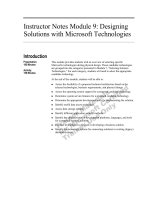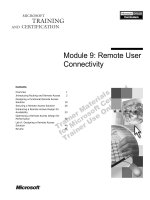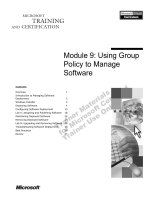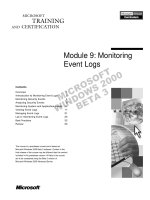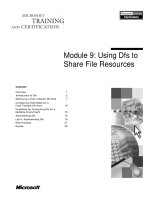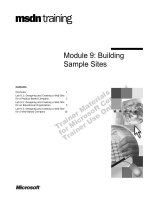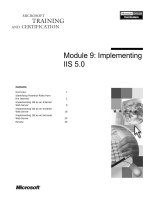Module 9 slot 1 (1)
Bạn đang xem bản rút gọn của tài liệu. Xem và tải ngay bản đầy đủ của tài liệu tại đây (666.23 KB, 34 trang )
Module 9
Strings, Text IO, and Audio
Learning Objectives
• Use String methods to process a CSV string
• Build a Unity game that outputs text
• Build a Unity game that plays sound effects
Strings
Content
• The String Class
• The StringBuilder Class
• Exercise 32: Yer Birthday
• Exercise 33: CSVs for Me
• Getting Input
• Putting It All Together
• Common Mistakes
9.1 The String Class
• A string is simply a sequence (or string) of characters.
• Example:
or
• C# lets us use the more compact syntax for assigning a value to a value type
for string, even though string is actually a reference type.
• We’ll typically use String when we’re talking about the class and string when
we’re talking about an object of the class, but they’re essentially the same
thing.
• you can get the complete set of methods from the MSDN documentation for
the String class.
9.1 The String Class
• Example: find out how long a string is by accessing the Length property
• find characters or strings within a string by using the IndexOf method
• find the location of a string in another string using the IndexOf method
• extract the substring that represents how many thousands of dollars the car
costs from carPrice
9.2 The StringBuilder Class
• The String class is very useful in C#, and it is used a lot. But it's immutable.
• Once we create a string object, we can't change that object. We can certainly make
changes and put them in a different string object (that's exactly what the Substring
method does), but sometimes what we really want to do is change this object
instead of creating a new one.
• Use the StringBuilder class instead of a string.
• We have to explicitly use the class constructor when we create a
StringBuilder object:
• add the hyphen to lastName
9.2 The StringBuilder Class
• What if we know we're done changing lastName and we want to put it into a string
variable called finalLastName rather than a StringBuilder? We use the ToString
method to convert the StringBuilder object to a string:
• The StringBuilder class also provides other useful methods, including
methods that let us remove substrings, insert substrings at particular
locations, and even replace substrings with other substrings.
Exercise 32: Yer Birthday
• View LMS
Exercise 33: CSVs for Me
• View LMS
9.3 Getting Input
• Console Class Documentation
9.3 Getting Input
• ReadLine Method Documentation
9.3 Getting Input
• code to read in a user name
• “converts the string representation of a number to its 32-bit signed integer
equivalent.” – the Parse method
9.4 Putting It All Together
The problem description:
Read in the names (first name, middle initial, and last name) of three
different people from the user. Print the three names in the following format:
lastName, firstName middleInitial. Also, identify the last names that are
hyphenated.
• Understand the Problem
• After printing the 3 names in the above format (we HAVE to meet that requirement),
let's print the three last names again with an indicator of whether or not they're
hyphenated, like:
9.4 Putting It All Together
• Design a Solution
• Class Diagram for the Name Class
9.4 Putting It All Together
• Design a Solution
• Write Test Cases
9.4 Putting It All Together
• Design a Solution
• Write the Code
9.4 Putting It All Together
• Write the Code
9.4 Putting It All Together
• Write the Code
9.4 Putting It All Together
• Write the Code
